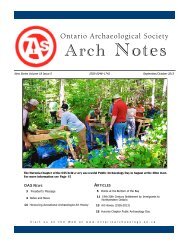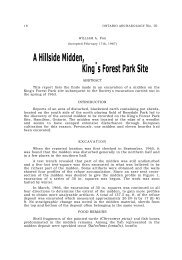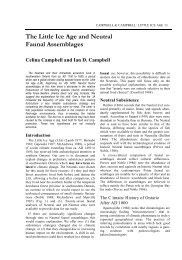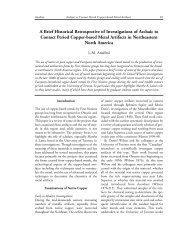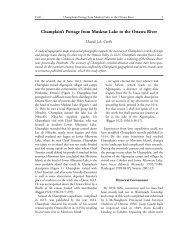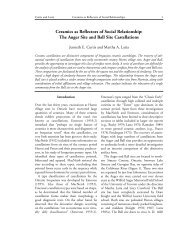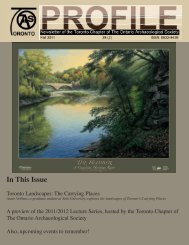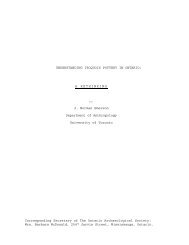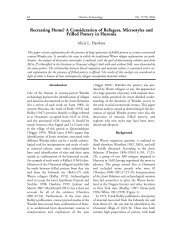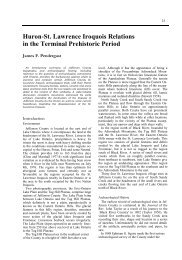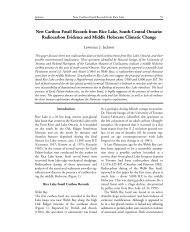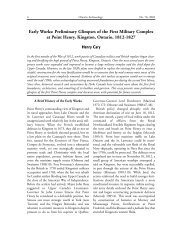accelerator-dating the weiser site, kent county, ontario: new ...
accelerator-dating the weiser site, kent county, ontario: new ...
accelerator-dating the weiser site, kent county, ontario: new ...
Create successful ePaper yourself
Turn your PDF publications into a flip-book with our unique Google optimized e-Paper software.
STOTHERS et al. ACCELERATOR-DATING THE WEISER SITE 1ACCELERATOR-DATING THE WEISER SITE,KENT COUNTY, ONTARIO:NEW PERSPECTIVES ON THE WOLF TO FORTMEIGS PHASE TRANSITION IN THE WESTERNLAKE ERIE REGIONDavid M. Sto<strong>the</strong>rs, Timothy J. Abel and James R. GravesThe Weiser Site (AdHo-1) and <strong>the</strong> Wolf to FortMeigs phase transition in <strong>the</strong> western Lake Erieregion were formerly estimated to date to circaA.D. 1400, based on ceramic seriations andradiocarbon assays derived from research innorthwestern Ohio. A <strong>new</strong> suite of radiocarbonassays, including two AMS assays obtained from<strong>the</strong> Weiser <strong>site</strong> itself has allowed a refinement ofthis estimate. Based on a consideration of <strong>the</strong>se<strong>new</strong> assays along with expanded understandingsof ceramic seriation, <strong>the</strong> Wolf to Fort Meigs phasetransition is now believed to date to <strong>the</strong> middle of<strong>the</strong> fifteenth century. The implications of thisrevised chronology are discussed.INTRODUCTIONThe purposes of this paper are to reportseveral <strong>new</strong> C 14 assays pertaining to <strong>the</strong> Wolf toFort Meigs phase transition, particularly tworecent <strong>accelerator</strong> C 14 assays obtained from <strong>the</strong>Weiser Site (AdHo-1), and to discuss <strong>the</strong>implications of <strong>the</strong>se <strong>new</strong> assays in light of<strong>new</strong>er understandings regarding ceramicseriation and <strong>the</strong> late prehistoric culturalchronology of southwestern Ontario, sou<strong>the</strong>asternMichigan and northwestern Ohio. Inshort, <strong>the</strong>se <strong>new</strong> data allow <strong>the</strong> temporalrefinement of <strong>the</strong> Wolf to Fort Meigs phasetransition, and inferences regarding <strong>the</strong> dynamicsof late prehistoric culture change in <strong>the</strong>western Lake Erie region between circa A.D.1400-1500.THE FORT MEIGS PHASE OFTHE SANDUSKY TRADITIONThe Sandusky Tradition developed in northcentral and northwestern Ohio (see Figure 1)(Sto<strong>the</strong>rs et al. 1994). Cultural continuity from aMiddle Woodland base has been documentedfor an ensuing Late Woodland aspect, characterizedby <strong>the</strong> Eiden (A.D. 1000-1250), Wolf(A.D. 1250-1450), Fort Meigs (A.D. 1450-1550)and Indian Hills (A.D. 1550-1643) phases. Thiscultural sequence is distinct from <strong>the</strong> neighbouringand somewhat temporally overlappingWestern Basin Tradition, which appears to haveemerged from <strong>the</strong> Lake St. Clair region during<strong>the</strong> Middle Woodland time period. At differenttimes, both of <strong>the</strong>se cultural traditions occupiedsouthwestern Ontario, sou<strong>the</strong>ast Michigan, andnorthwestern Ohio. This temporal and geographicoverlap has resulted in much debateover <strong>the</strong> taxonomy and ethnicity of LateWoodland populations in this region (cf.Murphy and Ferris 1990; Sto<strong>the</strong>rs et al. 1994).In this paper we adhere to <strong>the</strong> Late Woodlandtaxonomy and interpretation we haveespoused for some time. The Western BasinTradition is believed to have been absorbed byOntario Iroquoians and o<strong>the</strong>r groups by circaA.D. 1300. The Sandusky Tradition, on <strong>the</strong> o<strong>the</strong>rhand, is believed to have culminated in severalnamed groups of <strong>the</strong> historic Assistaeronon, aCentral Algonquian-speaking conglomerationtraditionally believed to have inhabited <strong>the</strong>sou<strong>the</strong>rn Great Lakes (Sto<strong>the</strong>rs et at 1994,
2 ONTARIO ARCHAEOLOGY No. 67, 1999DATE TIME PERIOD SANDUSKYTRADITIONAD. 1650 Protohistoic Indian Hills PhaseA.D. 1550Fort Meigs PhaseWESTERN BASINTRADITIONDispersal IntoA.D. 1450 Wolf Phase Southwestern Ontario.Nor<strong>the</strong>rn Indiana, &Nor<strong>the</strong>rn MichiganAD. 1350AD. 1300Springwells PhaseAD. 1250 Late WoodlandAD. 1200 Elden Phase Younge PhaseAD. 1000A.D. 750AD. 500AD.B.C.Green Creek Phase Riviera Cu Vase PhaseGibraltar PhaseDIscontinuityMiddle Woodland Each Phase UndefinedEarly WoodlandMiddle WoodlandLeimbach Phase Providence Phase600 B.C. Transitional Kendera Phase Williams Phase1000 B.C. Late Archaic Firelands Phase Riverside Phase2500 B.C. Early Archaic7600 B.C. Paleolndian TransientPopulations10000 B.C.Figure 1. Cultural Sequence for Western Basin of LakeErie.Sto<strong>the</strong>rs 1994a; Sto<strong>the</strong>rs and Koralewski 1996).The Sandusky Tradition terminates at <strong>the</strong> end of<strong>the</strong> protohistoric Indian Hills phase with <strong>the</strong>dispersal of Central Algonquian populationsfrom nor<strong>the</strong>rn Ohio and sou<strong>the</strong>astern Michigan,following hostilities with <strong>the</strong> Neutral and o<strong>the</strong>rgroups in <strong>the</strong> early seventeenth century(Sto<strong>the</strong>rs and Graves 1983:121).A decade ago, <strong>the</strong> Wolf to Fort Meigs phasetransition was believed to be bracketed betweenA.D. 1350-1400. This estimate was basedparticularly on radiocarbon assays receivedfrom <strong>the</strong> Weiser and Fort Meigs <strong>site</strong>s (seeSto<strong>the</strong>rs et al. 1984). A model of gradual transitionwas assumed, from general Late WoodlandWolf phase culture characterized by grit-temperedParker Festooned pottery, to Fort Meigsphase culture characterized by hallmarks suchas shell tempering, applique strips, and straphandles (Sto<strong>the</strong>rs and Graves 1983, 1985). Thisdevelopment was seen as <strong>the</strong> extension of anUpper Mississippian horizon into <strong>the</strong> sou<strong>the</strong>rnGreat Lakes, firmly dated to <strong>the</strong> middle fourteenththrough early fifteenth centuries A.D.(see Rutter 1984; Sto<strong>the</strong>rs and Graves 1985).Since <strong>the</strong>n, however, <strong>new</strong> radiocarbon assayshave been obtained from numerous Wolf phase<strong>site</strong>s, making it <strong>the</strong> most heavily dated phase in<strong>the</strong> Sandusky Tradition sequence (Sto<strong>the</strong>rs et al.1994). These <strong>new</strong> assays (Table 1) suggest thatWolf phase components, characterized by adominance of grit-tempered Parker Festoonedpottery (Abel 1995; Lee 1958), continue well into<strong>the</strong> fifteenth century This temporal placementmade <strong>the</strong>m as late as or later than <strong>the</strong> earliestFort Meigs phase components, understood atthat time to date between A.D. 1400-1550.Given our relative lack of knowledge concerning<strong>the</strong> Fort Meigs phase, we decided that <strong>the</strong> Wolfphase should be extended to A.D. 1450. TheIndian Hills phase, characterized by a dominanceof Indian Hills Stamped pottery (Graves 1984;Tucker 1981), is firmly dated by radiocarbonassays and historical documentation betweenA.D. 1550-1643. This leaves <strong>the</strong> Fort Meigsphase pinched between A.D. 1450-1550. Notingthat <strong>the</strong> developments of <strong>the</strong> Fort Meigs phaseappear to have been in vogue for such a shortduration of time, when compared to o<strong>the</strong>rdevelopments in <strong>the</strong> sequence, we believed thata <strong>new</strong> look at <strong>the</strong> Fort Meigs phase seemedwarranted.To test <strong>the</strong> validity of a relatively short FortMeigs phase development, we submitted several<strong>new</strong> Fort Meigs phase carbon samples foranalysis, to see if <strong>the</strong>se samples would confirmthose run a decade ago. The first samples to beselected were from <strong>the</strong> Fort Meigs phase type<strong>site</strong>. Located on a bluff overlooking <strong>the</strong> MaumeeRiver in Maumee, Ohio (Figure 2), <strong>the</strong> Fort Meigs<strong>site</strong> has been <strong>the</strong> location of several seasons ofexcavation that produced an abundantly richcultural assemblage. From accounts of <strong>the</strong> <strong>site</strong>penned during <strong>the</strong> construction of <strong>the</strong> historicalgarrison at Fort Meigs, and from more recentarchaeological excavations, it is clear that <strong>the</strong>Fort Meigs <strong>site</strong> represented a fortified villagecomponent greater than two hectares, and possiblyapproaching three hectares in size (Rutter1984). Radiocarbon assays submitted in 1974suggested that <strong>the</strong> <strong>site</strong> dated between A.D. 1350-1450 (Sto<strong>the</strong>rs 1975a:44), a placement believedto be supported by an assemblage diagnostic of<strong>the</strong> Midwestern Upper Mississippian culturalhorizon (Rutter 1984).The <strong>new</strong> assays obtained from <strong>the</strong> Fort Meigs<strong>site</strong> are 340 ± 80 B.P. (I-16,458), and 525 ± 70B.P. (GX-16871). These calibrate, using
STOTHERS et at ACCELERATOR-DATING THE WEISER SITE... 3Figure 2. Sandusky Tradition Sites Mentioned in Text: Weiser (1), Libby-Miller (2) Liahn 1(3), Wolfe Creek (4),Whittlesey Earthwork (5), Baker 1 (6), Pearson (7), Miller's Ridge and Hereford Hill (8), Blue Banks (9), Bear Fort (10),Petersen (11), Fort Meigs and Orleans Park (12), MacNichol (13), Dodge (14), LaSalle (15), Moccasin Bluff (16).CALIB 3.03c for Macintosh (Stuiver and Reimer1995), to A.D. 1430 (1520, 1590, 1620) 1950 andA.D. 1300 (1420) 1480, respectively, using a twosigma deviation. GX-16871 appears to corroborateprevious estimates of <strong>the</strong> Fort Meigs <strong>site</strong>temporal position, between A.D. 1350-1450. I-16,458, however, suggests a later placement for<strong>the</strong> <strong>site</strong>. This latter assay, on <strong>the</strong> o<strong>the</strong>r hand,more favourably agrees with ceramic seriationestimates that place shell tempering and o<strong>the</strong>rFort Meigs phase hallmarks in <strong>the</strong> fifteenth toearly sixteenth centuries (Abel 1995), ra<strong>the</strong>r thanin <strong>the</strong> fourteenth century (cf. Sto<strong>the</strong>rs et at 1984).This alternative placement also makes moresense in light of sixteenth and seventeenthcentury assays derived from o<strong>the</strong>r Fort Meigsphase components such as Whittlesey Earthwork(Davis et al. 1976), Liahn I (Kenyon 1988), WolfeCreek (Foster 1982, 1990; Fox 1978) andMacNichol (Sto<strong>the</strong>rs 1975b; Sto<strong>the</strong>rs and Pratt1981).We believed that <strong>the</strong> most telling assays wouldbe those derived from a transitional Wolf to FortMeigs phase <strong>site</strong>. This component should bracket<strong>the</strong> inception of those diagnostic hallmarks suchas shell-tempering, notched applique strippottery, and strap handles. To date, <strong>the</strong> only welldocumented <strong>site</strong> of this type is <strong>the</strong> Weiser <strong>site</strong>,located in southwestern Ontario (Sto<strong>the</strong>rs et al.1984). Two carbonized samples scraped from <strong>the</strong>interiors of two Weiser <strong>site</strong> rimsherds weresubmitted for radiocarbon assay in 1993 and1994.THE WEISER SITE (AdHo-1)The Weiser <strong>site</strong> (AdHo-1) is located in extremesouthwestern Ontario, in <strong>the</strong> Lake St. Clair Deltaarea (Figure 2). Based on early reports and morerecent research (see Kroon 1972, 1974; Reid1978), <strong>the</strong> Weiser <strong>site</strong> seems to represent
STOTHERS et at ACCELERATOR-DATING THE WEISER SITE... 5a single village component that was once fortifiedwith at least a circular ear<strong>the</strong>n embankment, andperhaps a concentric inner palisade (Reid 1978:5;Sto<strong>the</strong>rs et in. 1984:62-63). Daub from <strong>the</strong> <strong>site</strong>suggests wattle and daub structures existed in<strong>the</strong> interior of <strong>the</strong> village, although none weredelineated during excavations (Reid 1978).In 1982, all of <strong>the</strong> diagnostic Weiser <strong>site</strong>materials from both <strong>the</strong> University of Windsorand <strong>the</strong> National Museum of Man (now <strong>the</strong>Canadian Museum of Civilization) (e.g., Figures3-4) were analyzed by University of Toledoresearchers, with <strong>the</strong> aid of accompanying fieldnotes (Sto<strong>the</strong>rs et at 1984). The cultural assemblagesderived from <strong>the</strong> <strong>site</strong> include faunal, floral,lithic, and ceramic materials. The faunalassemblage consists of fish and mammalianremains in almost equal proportions, as well asminor percentages of reptilian and avian remains(Foster 1978; Kroon 1972; Reid 1978). The lithicassemblage consists of typical reductiondebitage, most of which is derived from Bayportlithic sources from Saginaw Bay in Michigan. Thediagnostic chipped stone assemblage consists of"Madison-like" triangular bifaces, bifacial "snubnose"end-scrapers, gravers, spokeshaves, anddrills (Reid 1978:8). Notched limestone cobbles,undoubtedly fashioned for use as netsinkers,were also found in abundance (Kroon 1972).Several ceramic pipe fragments, including RingBowl, Elongated Ring Bowl, Barrel Bowl, andTrumpet Bowl types (Figure 4a-c) were analyzedby University of Toledo researchers (Sto<strong>the</strong>rs etin. 1984:64-65).The <strong>site</strong> has yielded a ceramic assemblage of185 vessels, of which 91 percent (n=168) are grittempered,and nine percent (n=17) are shelltempered.The majority of <strong>the</strong> diagnostic sherdshave stylistic attributes typical of <strong>the</strong> Wolf to FortMeigs phase transition such as push-pull,trailing, and notched horizontal applique strips.Fifty-six percent of <strong>the</strong> rims are typed as FortMeigs Notched Applique (Rutter 1984), while 24percent are of <strong>the</strong> Parker Festooned ceramic type(Abel 1995; Lee 1958). All of <strong>the</strong> ParkerFestooned vessels are grit-tempered, while <strong>the</strong>Fort Meigs Notched Applique type wasrepresented by both grit and shell-temperedvariants. As suggested by ceramic seriation(Figure 5), <strong>the</strong> Weiser <strong>site</strong> represents an earlyFort Meigs phase occupation (Sto<strong>the</strong>rs et in.1994; Sto<strong>the</strong>rs et in. 1984:75).Weiser Site Radiometric AssaysThe first assay was obtained on 1.9 gm ofcarbonized food residue removed from <strong>the</strong>interior rim of a vessel typed as Fort MeigsNotched Applique var. Trailed (Abel 1995:354-357; Rutter 1984). The rim is grit tempered witha rounded lip (6 mm thick) and has simplerounded castellations (Figure 3b). The carbonencrustation was removed by scraping <strong>the</strong> interiorof <strong>the</strong> rim with a clean dental pick. Thesample was sent to <strong>the</strong> NSF-funded University ofArizona Accelerator Mass Spectrometry Facility toobtain an AMS C 14 assay. The resultant assay of415 ± 55 BP (AA-7458) was adjusted for a C'2113fractionation value of -23.7 000 The assaycalibrates to A.D. 1420 (1460) 1640 (two sigma)using CALIB 3.03c (Stuiver and Reimer 1995).The second assay was obtained on .9 gm ofcarbonized and encrusted food residue re-movedfrom <strong>the</strong> rim interior of a vessel typed as IndianHills Stamped var. Trailed (Abel 1995:354-357;Tucker 1981). The vessel is grit tempered with arounded lip (5.5 mm thick) and has simplerounded castellations (Figure 4f). Once again, <strong>the</strong>carbon encrustation was obtained by scraping<strong>the</strong> interior of <strong>the</strong> rim segment with a dentalpick. This sample was sent to <strong>the</strong> LawrenceLivermore National Lab, in care of Beta AnalyticInc. to obtain an AMS C 14 assay The resultantassay of 430 ± 80 B.P. (Beta 52339; CAMS 2683)calibrates to A.D. 1400 (1450) 1650 (two sigma)using CALEB 3.03C (Stuiver and Reimer 1995).ImplicationsThe <strong>new</strong> Weiser <strong>site</strong> radiocarbon assays, inconjunction with revised ceramic seriation estimates(see Abel 1995; Sto<strong>the</strong>rs et in. 1994), suggestthat <strong>the</strong> <strong>site</strong> was occupied during <strong>the</strong> middleof <strong>the</strong> fifteenth century A.D., not <strong>the</strong> middle of <strong>the</strong>fourteenth century as previously believed. Thisplacement supports suggestions by Fox (1980:11)and Murphy and Ferris (1990:224) that <strong>the</strong>Weiser <strong>site</strong> is roughly contemporaneous with <strong>the</strong>Ontario Iroquoian Lawson <strong>site</strong> near London.Parker Festooned now appears to be <strong>the</strong> hallmarkceramic type of <strong>the</strong> Sandusky Traditionfrom at least A.D. 1250 until well into <strong>the</strong> fifteenthcentury A.D. (Sto<strong>the</strong>rs et in. 1994). As such, <strong>the</strong>Wolf phase temporal bracket has been adjustedto reflect this understanding. This placement
6 ONTARIO ARCHAEOLOGY No. 67, 1999Figure 3. Selected Ceramic Vessels from <strong>the</strong> Weiser Site. Grit-tempered Fort Meigs Notched Applique Rim (a);Grit tempered Fort Meigs Notched Applique variety Trailed Rim from Vessel Radiocarbon Dated to 425±55 B.P.(AA-7458) (b); Grit tempered Fort Meigs Notched Applique variety Push-Pull Rim (c); Grit tempered Fort MeigsNotched Applique Rim with tapered and bilaterally notched strap handle (d); Grit tempered Fort Meigs NotchedApplique Rim with plain tapered strap handle (e); Reconstructed grit tempered Fort Meigs Notched Appliquevariety Trailed Vessel (f). All vessels are from <strong>the</strong> National Museum of Canada Collection.
STOTHERS et al. ACCELERATOR-DATING THE WEISER SITE... 7Figure 4. Selected Pipes from <strong>the</strong> Weiser Site and Indian Hills Series Ceramic Vessels. Plain Trumpet Bowl Pipewith Burnished Red Ochre Wash or Slip (a); Iroquois Ring Bowl Pipe Fragment (b); Short Barrelled Pipe Bowlwith Annular Punctates (c); Shell tempered Indian Hills Stamped variety Trailed Vessel from <strong>the</strong> Petersen Site(d); Shell tempered Indian Hills Stamped variety Trailed Rim from <strong>the</strong> Indian Hills Site (e); Grit temperedIndian Hills Stamped variety Trailed Rim from <strong>the</strong> Weiser Site, Radiocarbon Dated to 430±80 B.P. (Beta-52339/CAMS-2683) (f).
10 ONTARIO ARCHAEOLOGY No. 67, 1999Figure 7. Selected Fort Meigs and Mixter Series Vessels. Shell tempered Fort Meigs Notched AppliqueVessel with cord-roughened, fabric impressed body from <strong>the</strong> Hereford Hill Site (a); Grit tempered MixterStamped Vessel with plain smooth body from <strong>the</strong> Cemetery Ridge Site (b), Grit tempered Mixter StampedVessel with plain smooth body from <strong>the</strong> Weilnau Site (c); Shell tempered Fort Meigs Notched AppliqueVessel with cord-roughened, fabric impressed body and fluted neck from <strong>the</strong> Pearson Site (d).
STOTHERS et al. ACCELERATOR-DATING THE WEISER SITE... 11Figure 8. Grit tempered Parker Festooned variety Push-Pull Vessels from <strong>the</strong> Petersen Site (a-c).
12 ONTARIO ARCHAEOLOGY No. 67, 1999ceramic types Mixter Dentate and Mixter ToolImpressed (see below) (Shane 1967). Festoons on<strong>the</strong> rim executed in stamping, push-pull ortrailing define <strong>the</strong> ceramic type Parker Festooned(Abel 1995; Lee 1958).The third and final ceramic ware of <strong>the</strong>Sandusky Tradition has been called Fort MeigsWare (Abel 1995; Figure 7a, d). Unlike MixterWare, Fort Meigs Ware is characterized by thin,fabric impressed, and globular-shaped jars with arounded or sub-conical vessel base. The vesselwalls constrict sharply at a well-defined shoulderto a shallow neck, creating a characteristicallywide-mou<strong>the</strong>d vessel. The rims are short andexcurvate, usually with modified, or at <strong>the</strong> veryleast splayed lips. The lips are rounded and laterflat, facing outward, and predominantlysmoo<strong>the</strong>d during <strong>the</strong> Fort Meigs phase. During<strong>the</strong> subsequent Indian Hills phase, <strong>the</strong> vessel lipis usually embellished with dentate stamps. Therim diameter is almost equal to <strong>the</strong> diameter of<strong>the</strong> vessel at <strong>the</strong> shoulder. There are two motifsthat predominate among Fort Meigs Ware vessels.Notched horizontal applique strips define<strong>the</strong> ceramic type Fort Meigs Notched Applique(Rutter 1984). Vertical or oblique linear or dentatestamps define <strong>the</strong> ceramic type Indian HillsStamped (Graves 1984; Tucker 1981).In summary, <strong>the</strong>n, four core motifs make up<strong>the</strong> Late Woodland ceramic sequence of <strong>the</strong>Sandusky Tradition. These are, in chronologicalorder, (1) checkering, (2) festoons, (3) notchedhorizontal applique strips, and (4) vertical linearor dentate stamps. Because <strong>the</strong>se attributes arechronologically ordered, <strong>the</strong>y can be ranked,with each motif being defined as mutually exclusive.Thus, <strong>the</strong> presence of attribute (4) cancelsout all o<strong>the</strong>rs should <strong>the</strong>y appear on <strong>the</strong> samerim, and constitutes <strong>the</strong> defining attribute whenassigning <strong>the</strong> rim to a specific ceramic type. Thisallows any rim to be assigned unambiguously toone and only one ceramic type within <strong>the</strong>Sandusky Tradition. Lower-ranked motifs maybeused to define sub-types of <strong>the</strong> major type categories(Abel 1995:355)In this seriation, a few ceramic types aresuperfluous or o<strong>the</strong>rwise problematic. Theceramic types Mixter Dentate and Mixter Tool-Impressed (Abel 1995; Shane 1967; Figure 7b, c)are ambiguous under this taxonomic method,differing only in execution and not in motif. Nosignificant differences exist in ei<strong>the</strong>r <strong>the</strong>geographic distribution or temporal durationof <strong>the</strong>se two types. As such, <strong>the</strong> use of two typesis superfluous under this method, and one typeyields <strong>the</strong> same resulting seriation. It has beensuggested that this type be named MixterStamped (Abel 1995:472). The two former typetaxa would constitute varieties (i.e., var. Dentateand var. Tool-Impressed).A <strong>new</strong>ly defined ceramic type has been calledMixter Festooned (Abel 1995:343-344). It typicallydisplays a single chevron or festoon nestedbetween zones of stamping above and below Thezone above <strong>the</strong> chevron or festoon is typicallyMixter-like, displaying a horizontal motif of verticalstamping. The zone beneath is similar, but <strong>the</strong>stamping is oblique. It is nei<strong>the</strong>r characteristic of<strong>the</strong> previous Mixter types, nor are <strong>the</strong> festoonsdistinct enough to warrant placement in <strong>the</strong>Parker Festooned type. It is clearly a transitionalmotif, and is placed as such in <strong>the</strong> seriation.A second <strong>new</strong> type, named Hudson Horizontal(Abel 1995:360-362; Sto<strong>the</strong>rs and Abel 1989:120), is characterized by horizontal motifs executedin push-pull or trailing on a smoo<strong>the</strong>d rim.The type displays striking similarity to <strong>the</strong>Whittlesey Tradition Reeve Horizontal type(Murphy 1971), and it has been suggested thatHudson Horizontal is in reality a WhittleseyTradition type (Koralewski 2000; Sto<strong>the</strong>rs andKoralewski 1996). There may be clear continuityfrom <strong>the</strong> Mixter Stamped ceramic type, however.The Hudson Horizontal motif may be achieved bysimply connecting <strong>the</strong> stamps typical of MixterStamped by interrupted linear or trailing. Thistransition from stamping to trailing also takesplace between earlier and later varieties of ParkerFestooned (Abel 1995; see below). Hence, <strong>the</strong>re isgood reason to suspect that a similar stylistictransformation could have occurred in MixterStamped, making Hudson Horizontal part of aMixter Series continuum. Hudson Horizontal isnone<strong>the</strong>less a minority type, never reaching anydominance in <strong>the</strong> Sandusky ceramic tradition.Parker Festooned plainly develops out of <strong>the</strong>Mixter Festooned ceramic type (Abel 1995:472-474; Sto<strong>the</strong>rs et al. 1994:145). At present, threevarieties of <strong>the</strong> Parker Festooned ceramic type arerecognized: var. Stamped, var. Push-Pull (Figure8), and var. Trailed. These type varieties aredefined on <strong>the</strong> basis of <strong>the</strong> technique used toexecute <strong>the</strong> festoon motif. The Stamped variety ofParker Festooned appears to be <strong>the</strong> earliest of <strong>the</strong>three, emerging circa A.D. 1200 based on
STOTHERS et al ACCELERATOR-DATING THE WEISER SITE... 13Figure 9. Selected Fort Meigs and Parker Festooned Ceramic Vessels. Grit tempered Fort Meigs NotchedApplique variety Trailed Rim from <strong>the</strong> Weiser Site (a); Shell tempered Fort Meigs Notched AppliqueVessel with Fluted Neck from <strong>the</strong> Weiser Site (b); Grit tempered Parker Festooned variety Trailed Rimfrom <strong>the</strong> Petersen Site (c); Grit tempered Parker Festooned variety Trailed Rim from <strong>the</strong> Pearson Site (d);Grit tempered Parker Festooned variety Trailed Rim from <strong>the</strong> Bluebanks/Hudson Site (e).
14 ONTARIO ARCHAEOLOGY No. 67, 1999seriation estimates and <strong>the</strong> current radiocarbonchronology The Stamped variety is quicklysuperceded by variety Push-Pull (Figure 8),which appears to be bracketed between circaA.D. 1250 and 1450 based upon seriation estimatesand radiocarbon assays. The Trailed variety(Figure 9c-e) appears to evolve out of <strong>the</strong>Push-Pull variety around A.D. 1400, and continuesthrough <strong>the</strong> decline of <strong>the</strong> Parker Festoonedceramic type through <strong>the</strong> fifteenth centuryParker Festooned appears occasionally in somesixteenth century assemblages, but virtuallyfaded from existence by A.D. 1500 (Abel 1995).By circa A.D. 1400, <strong>the</strong>re appears to be aradical shift in Sandusky Tradition motif preference,from festoons to notched applique strips.This <strong>new</strong> motif is curious, since it appears tohave no apparent developmental precursorsduring <strong>the</strong> Wolf phase. It was once believed thatapplique strip festoons, an attribute occasionallyseen on Wolf phase Parker Festoonedceramic vessels (see Lee 1958), and which alsoappears at <strong>the</strong> Weiser <strong>site</strong> (see Sto<strong>the</strong>rs et al.1984), formed <strong>the</strong> stylistic base from whichnotched horizontal applique strips evolved. Theanalysis of an increasing sample of Wolf phaseceramic assemblages, however, has suggestedthat <strong>the</strong> applique festoon attribute is present onless than 10 percent of <strong>the</strong> vessels. It appearspredominantly during <strong>the</strong> middle Wolf phase(<strong>the</strong> fourteenth century), on a minority of vesselsthat would o<strong>the</strong>rwise be typed as MixterTool-Impressed or Mixter Dentate, as well as onsome Parker Festooned vessels (Abel 1995). It ishence not <strong>the</strong> likely base from which notchedhorizontal applique strips evolved. Notchedhorizontal applique strips appear to be a foreignattribute, introduced into <strong>the</strong> SanduskyTradition along with a host of o<strong>the</strong>r culturalattributes, among <strong>the</strong>m shell-tempering.The Inception of Shell TemperingThrough a larger sample of both ceramicassemblages and radiocarbon assays, we arebeginning to get a clearer picture of <strong>the</strong> inceptionof shell-tempering and o<strong>the</strong>r attributes into<strong>the</strong> Sandusky ceramic tradition. Figures 5 and 6provide frequencies from ceramic assemblagesof several Sandusky Tradition components. Thefrequencies are of selected ceramic seriesincluding <strong>the</strong> Mixter Series (Mixter Tool-Impressed/Dentate, Mixter Festooned), FortMeigs Series (Fort Meigs Notched Applique, FortMeigs Modified Lip, Fort Meigs ExteriorImpressed Lip), and Indian Hills Series (IndianHills Stamped, Indian Hills Punctate). ParkerFestooned currently belongs to no larger series.The percentages are of typed vessels relative to<strong>the</strong> total typed vessel assemblage for eachcomponent. Minority types (e.g. HudsonHorizontal, Petersen Plain, and Fort Meigs Plain)as well as untyped vessels (vessels which haveample attributes to be typed, but do not conformto currently-defined types), are not includedin this report since <strong>the</strong>y are not pertinent to<strong>the</strong> discussion at hand. As such, not all of <strong>the</strong> frequenciesmay total 100%. The percentage ofshell-tempering is derived from <strong>the</strong> total numberof typable vessels for each component.The Petersen <strong>site</strong> is located along <strong>the</strong> PortageRiver in northwestern Ohio (Figure 2). Two lateWoodland village components are present at this<strong>site</strong> representing <strong>the</strong> Wolf and Indian Hillsphases, respectively The ceramic assemblage of<strong>the</strong> Wolf phase component consists of some 382vessels, predominantly of <strong>the</strong> Parker Festoonedceramic type (77 percent). The remainder of <strong>the</strong>assemblage is composed of Mixter series andminority ceramic types. Radiocarbon datessuggest that <strong>the</strong> Wolf phase component wasoccupied during <strong>the</strong> middle of <strong>the</strong> fourteenthcentury (Abel 1995). The ceramic assemblage of<strong>the</strong> Wolf phase component produced no shelltemperedceramics.The Pearson South <strong>site</strong> is located on GreenCreek in northwestern Ohio (Figure 2). Theceramic assemblage of this village <strong>site</strong> consistsof 57 vessels, predominantly of <strong>the</strong> ceramic typeParker Festooned (84 percent; Figure 9d). Minorfrequencies of <strong>the</strong> ceramic types HudsonHorizontal, Mixter Festooned, and Indian HillsStamped are also present. It is now interpretedthat <strong>the</strong>re are no shell tempered ceramics associatedwith Pearson South. Those reportedearlier to be present in Wolf phase features arebelieved to have been derived from an overlyingFort Meigs phase midden (cf Sto<strong>the</strong>rs and Pratt1981:97-98). A similar interpretation is nowaccepted for <strong>the</strong> occasional occurrence of shelltemperedsherds in Wolf phase contexts at <strong>the</strong>MacNichol, Dodge, and LaSalle <strong>site</strong>s (Figure 2)(Sto<strong>the</strong>rs and Pratt 1981:97-98). Pearson Southis believed to date to <strong>the</strong> late fourteenth centurybased on ceramic seriation estimates. The onlyradiocarbon assay from <strong>the</strong>
STOTHERS et al. ACCELERATOR-DATING THE WEISER SITE... 15component, cal A.D. 1400(1440)1630 (UGa-2536, two sigma) (Bowen 1980; Stuiver andReimer 1995), seems to support this placement(cf. Sto<strong>the</strong>rs and Abel 1989).Excavations of <strong>the</strong> late Wolf phase componentof <strong>the</strong> Blue Banks <strong>site</strong> (Figure 2) yielded a ceramicassemblage of 73 vessels, of which 58 percentare characteristic of Parker Festooned (Figure9e) and 27 percent are characteristic of FortMeigs Notched Applique. The remainder of <strong>the</strong>assemblage is composed of minority types, predominantlyHudson Horizontal. A single detachednotched applique strip, two separatedstrap handles, and several bodysherds are <strong>the</strong>only shell tempered sherds found in <strong>the</strong> late Wolfphase layers. Like above, however, it is suspectedthat <strong>the</strong>se sherds are intrusive into <strong>the</strong>sedeposits from a stratigraphically overlying FortMeigs phase occupation. This later componentof <strong>the</strong> Blue Banks <strong>site</strong> may be <strong>the</strong> source of tworadiocarbon assays of A.D. 1440(1480)1650(Beta 7973) and A.D. 1430 (1520, 1590, 1620)1950 (I-15,911) (see Abel 1995:471), calibratedto two sigma (Stuiver and Reimer 1995). The lateWolf phase component of <strong>the</strong> Blue Banks <strong>site</strong> isbelieved, on <strong>the</strong> basis of ceramic seriation estimates,to date to circa A.D. 1400, which agreeswell with <strong>the</strong> third and final calibrated radiocarbonassay of A.D. 1320(1430)1610 (I-15,910, twosigma) (Sto<strong>the</strong>rs and Abel 1989).The Miller's Ridge <strong>site</strong> is located a short distanceto <strong>the</strong> east of <strong>the</strong> Pearson South component(Figure 2). Excavations <strong>the</strong>re beginning in1979 have revealed sections of a peripheralditch feature, as well as several interior refusepits and house structure segments. The ceramicassemblage of <strong>the</strong> Miller's Ridge <strong>site</strong> consists of121 vessels, of which 66 percent are Fort MeigsSeries vessel types. There are only minorfrequencies of Indian Hills Stamped (11 percent),Fort Meigs Plain (nine percent), andParker Festooned (two percent) (Koralewski2000). Approximately seven percent of <strong>the</strong>assemblage consists of <strong>the</strong> Whittlesey TraditionTuttle Hill Notched ceramic type (Murphy 1971).Four acceptable radiocarbon assays are nowavailable from this village <strong>site</strong>: A.D. 1480 (1650)1950 (Beta-84989), A.D. 1520(1660) 1950 (I-18,994), cal A.D. 1400(1430)1470 (I-18, 995),and A.D. 1430(1460)1630 (I-18,996) (previouslyunpublished; Stuiver and Reimer 1995). Webelieve <strong>the</strong> latter two assays to be most representativeof <strong>the</strong> true age of <strong>the</strong> <strong>site</strong>, estimatedto be in <strong>the</strong> middle to late fifteenth century Thiswould make it roughly contemporary with <strong>the</strong>Weiser <strong>site</strong>. The percentage of shell temperingat <strong>the</strong> Miller's Ridge <strong>site</strong> is 59 percent.The ceramic assemblage of <strong>the</strong> Fort Meigsphase type <strong>site</strong> contains a majority of FortMeigs Series vessels (42 percent) and only asmall percentage of Parker Festooned vessels(two percent). The remaining percentage in thatassemblage belongs to Fort Meigs Plain andIndian Hills Series (Indian Hills Stamped, IndianHills Punctate) ceramic types. The frequency ofshell-tempered ceramics at <strong>the</strong> Fort Meigs <strong>site</strong>approaches 100 percent (Rutter 1984). Basedon our current understandings of ceramic seriationdiscussed above, <strong>the</strong> Fort Meigs <strong>site</strong> isestimated to date to <strong>the</strong> early sixteenth century,or <strong>the</strong> end of <strong>the</strong> Fort Meigs phase. If our estimatesare correct, <strong>the</strong> Fort Meigs type <strong>site</strong> isroughly contemporary with <strong>the</strong> late prehistoriccomponent of <strong>the</strong> Liahn I <strong>site</strong>. The absence ofEuropean artifacts at <strong>the</strong> Fort Meigs <strong>site</strong> (seeRutter 1984) seems to support this conclusion.Ceramic Trends in Southwestern OntarioThe sequence of shell-tempering in southwesternOntario is now also beginning to beclarified (cf. Murphy and Ferris 1990:224).Figure 5 illustrates <strong>the</strong> seriation of ceramicassemblages from four southwest OntarioSandusky Tradition components. The percentagesare of typed vessels relative to <strong>the</strong> totalnumber of typed vessels in <strong>the</strong> componentassemblage. Again, <strong>the</strong> same ceramic seriescategories were used, and <strong>the</strong> same categoriesomitted for clarity The percentage of shell temperingis relative to <strong>the</strong> appropriate componentassemblage. Assumptions were made regarding<strong>the</strong> assignment of ceramics to specific componentsbased on assigned type. Iroquoian andWestern Basin Tradition types were assumed,based on our own interpretation, to relate to differentcomponents or at least to captive populationsresiding within those components(Sto<strong>the</strong>rs et al. 1994).The ceramic assemblage of <strong>the</strong> Weiser <strong>site</strong>(Sto<strong>the</strong>rs et al 1984:76) contains a 56 percent frequencyof Fort Meigs series ceramic types and a24 percent frequency of <strong>the</strong> Parker Festoonedtype. This ceramic type composition suggests aninitial Fort Meigs phase component <strong>dating</strong> to <strong>the</strong>middle of <strong>the</strong> fifteenth century, ra<strong>the</strong>r than to <strong>the</strong>
16 ONTARIO ARCHAEOLOGY No. 67, 1999middle of <strong>the</strong> fourteenth century as previouslybelieved. The two recently obtained radiocarbonassays support this proposed temporal placement.The Weiser <strong>site</strong> ceramic assemblage containsa nine percent frequency of shell tempering.The late prehistoric Sandusky Traditionceramic assemblage of <strong>the</strong> Liahn I <strong>site</strong> (Kenyon1988) (Figure 2) is composed of eight vessels, allof which may be assigned to Fort Meigs seriesceramic types. All but one of <strong>the</strong>se vessels isgrit-tempered (shell tempering = 12.5 percent).Based on two radiocarbon assays of cal A.D.1420(1470)1650 (DIC-1007b) and cal A.D. 1510(1650)1950 (DIC-1010b) (Fox 1982; Kenyon 1988),<strong>the</strong> Liahn I <strong>site</strong> is believed to represent an earlysixteenth century occupation (see also Murphyand Ferris 1990:224). Due to <strong>the</strong> extremely smallceramic sample, however, <strong>the</strong>se interpretationsare viewed as tenuous at best.The Wolfe Creek Site (Figure 2) has beeninterpreted by Foster (1990) as a Late Iroquoianvillage component. There is a sizable sample,however, of Sandusky Tradition Fort Meigs phaseceramics (36 percent of <strong>the</strong> overall vessel count)which, along with overlapping longhouse structures,may suggest two components, followedclosely in time. The Sandusky Tradition ceramicassemblage at <strong>the</strong> Wolfe Creek <strong>site</strong> consists of20 vessels, of which 45 percent are Fort MeigsNotched Applique, 45 percent are Fort MeigsModified Lip, and <strong>the</strong> remaining 10 percent areFort Meigs Plain (Figure 5). The percentage ofshell tempering in this vessel count is 24 percent.Radiocarbon determinations from <strong>the</strong> <strong>site</strong> clusterin two temporal brackets, one of which nicelycomplements an early sixteenth century estimatefor <strong>the</strong> age of this Fort Meigs phase ceramicassemblage.The Sandusky Tradition ceramic assemblageof <strong>the</strong> Libby-Miller <strong>site</strong> (cf. Murphy and Ferris1990; Stewart 1994), contains 32 percent shelltempering based on surface-derivedassemblages (Figure 5). Of 41 rim and necksherds derived from excavated contexts, 90percent are grit-tempered, and 10 percent areshell-tempered. Eleven vessels of <strong>the</strong> Fort MeigsNotched Applique ceramic type were identified in<strong>the</strong>se excavated contexts, while <strong>the</strong> majority of<strong>the</strong> fragmentary rim and neck sherds displayattributes typical of Fort Meigs ceramic types.European trade goods and ceramic seriationestimates augment a calibrated date of A.D.1410(1460) 1650 (BGS1596; Stewart 1994:56; Stuiver and Reimer1995), suggesting a temporal placement near<strong>the</strong> middle to late sixteenth centuryDiscussionIt appears that <strong>the</strong> transition from grit to shelltempering began in northwestern Ohio ceramicassemblages circa A.D. 1450 and progresseduntil circa A.D. 1550, at which time <strong>the</strong> percentageof shell-tempering appears to have been ator near 100 percent. In southwestern Ontario,<strong>the</strong> inception of shell-tempering as reflected at<strong>the</strong> Weiser <strong>site</strong> appears to have progressed littlein <strong>the</strong> ensuing century. In <strong>the</strong> absence of <strong>site</strong>sdisplaying predominantly shell-temperedceramic assemblages in southwestern Ontario,a complete transition from grit to shell temperingdoes not seem apparent (see also Murphyand Ferris 1990:224).NEW PERSPECTIVES ON THEWOLF TO FORT MEIGS PHASETRANSITIONThe Wolf to Fort Meigs phase transition ismainly characterized by a marked shift in vesselmanufacturing and decoration preferences (Abel1995). The characteristic of this shift appears tobe <strong>the</strong> relatively quick adoption of Fort MeigsWare, in <strong>the</strong> beginning almost exclusivelyassociated with <strong>the</strong> ceramic type Fort MeigsNotched Applique (Rutter 1984). By about A.D.1500, o<strong>the</strong>r motif types such as Fort MeigsExterior Impressed Lip and Indian HillsStamped (Graves 1984; Tucker 1981) emerge onFort Meigs Ware vessels.Nei<strong>the</strong>r Fort Meigs Ware, nor <strong>the</strong> Fort MeigsNotched Applique ceramic type, have any stylisticprecursors in <strong>the</strong> western Lake Erie region.The notched horizontal applique strip appearswith no o<strong>the</strong>r continuous attributes (such as festoonscarried over from Parker Festooned) untilA.D. 1500, when it is often associated withtrailed festoons and/or vertical dentate stamps.There are ceramic continuities that are contemporary,however. The ceramic type Fort MeigsPlain (Rutter 1984) appears to develop from itsgrit-tempered Wolf phase equivalent, PetersenPlain (Abel 1995), retaining <strong>the</strong> basic MixterWare vessel shape (see Sto<strong>the</strong>rs and Abel1989:Figure 9e). Indian Hills Stamped (Graves1984; Tucker 1981) appears to have a stylistic
18 ONTARIO ARCHAEOLOGY No. 67, 1999suggest that <strong>the</strong>se <strong>site</strong> clusters represent <strong>the</strong>prehistoric to protohistoric development of <strong>the</strong>Kouattoehronon (Sauk), Skenchioronon (Fox),and Totontaratonhronon (Mascouten) tribalgroups, respectively (see Sto<strong>the</strong>rs 1994a). Thelate prehistoric to protohistoric WhittleseyTradition, located in <strong>the</strong> lower Cuyahoga Valley ofnor<strong>the</strong>astern Ohio, has been identified as <strong>the</strong>Ontararonon (Kickapoo) (Sto<strong>the</strong>rs 1981, 1998a,1994a, 1998b).Ethnohistoric accounts suggest a close affinitybetween <strong>the</strong> historic Mascouten, Kickapoo, Sauk,Fox, and Potawatomi in opposition to a Neutral-Odawa alliance (summarized in Baerreis et al.1974; Callender 1962, 1978a, 1978b; Goddard1972, 1978). Sto<strong>the</strong>rs (1994a, 1994b, 1998a,1998b) has gone fur<strong>the</strong>r to suggest that thisaffinity represented an alliance among <strong>the</strong>Central Algonquian tribes of <strong>the</strong> sou<strong>the</strong>rn GreatLakes. The use of <strong>the</strong> term "Fire Nation" inseveral ethnohistoric documents refers moregenerally to <strong>the</strong> Central Algonquian tribes as awhole (Campeau 1987). Based on similarities inmaterial culture and language (Sto<strong>the</strong>rs andGraves 1985), Sto<strong>the</strong>rs sees this usage asreferring to a formal confederacy, or perhapswhat its authors saw as a confederacy, of fivetribes including <strong>the</strong> Mascouten, Kickapoo, Sauk,Fox and Wea (Ouiatonon) Miami. Based on <strong>the</strong>above data, we believe that <strong>the</strong> formal CentralAlgonquian tribes had <strong>the</strong>ir genesis during <strong>the</strong>Fort Meigs phase (A.D. 1450-1550). A CentralAlgonquian "Fire Nation" confederacy, if real,probably appeared during <strong>the</strong> early sixteenthcentury Noting <strong>the</strong> apparent west to eastconsolidation of tribes in <strong>the</strong> Nor<strong>the</strong>ast, <strong>the</strong> formationof <strong>the</strong> Neutral Confederacy may havepartially been a response to pressures exerted byallied Central Algonquian forces.There have been several attempts to explain<strong>the</strong> formation of tribal confederacies in <strong>the</strong>Nor<strong>the</strong>ast (Trigger 1990). We do not believe that<strong>the</strong>se changes were influenced directly byresistance to Mississippian domination or economicforces emanating from a Mississippian"core" (cf. Dincauze and Hasenstab 1989;Jamieson 1992). While o<strong>the</strong>rs have suggestedthat <strong>the</strong>se changes were ultimately caused byenvironmental degradation (Fecteau 1985;Fitzgerald and Jamieson 1985), <strong>the</strong>re is no evidencefor dramatic dietary shifts in northwesternOhio during <strong>the</strong> late prehistoric timeperiod (Sto<strong>the</strong>rs and Abel 2000). Alternatively,we see changing social relations and <strong>the</strong> strugglefor security as being <strong>the</strong> primary forcesinfluencing <strong>the</strong> spread of social change across<strong>the</strong> Great Lakes during <strong>the</strong> fifteenth and sixteenthcenturies (Trigger 1990; Williamson andRobertson 1994). Ultimately, <strong>the</strong>se transformationsmay be a response to <strong>the</strong> decline ofMississippian hegemony in <strong>the</strong> Midwest, and <strong>the</strong>inception of a "<strong>new</strong> world order", or moreprobably, several competing world orders in <strong>the</strong>sou<strong>the</strong>rn Great Lakes.CONCLUSIONSThe current temporal model for <strong>the</strong> Wolf to FortMeigs phase transition in <strong>the</strong> western Lake Erieregion is in need of reassessment and fur<strong>the</strong>rresearch. On <strong>the</strong> surface, <strong>the</strong> temporal inconsistenciesin <strong>the</strong> current model may be resolved by asimple modification of <strong>the</strong> temporal scale. It issuggested that <strong>the</strong> Wolf phase time bracketshould be shifted to A.D. 1250-1450, while <strong>the</strong>Fort Meigs phase time bracket should be shiftedto A.D. 1450-1550. The acceptance of this modification,however, raises several questions concerning<strong>the</strong> dynamics of <strong>the</strong> Wolf to Fort Meigsphase transition. The proposed chronology suggestsa long Wolf phase, followed by a very shortand ecliptic Fort Meigs phase. It is suggestedthat this transition may now be viewed as representativeof abrupt and radical social changes of<strong>the</strong> sort that may be produced by <strong>the</strong> adoptionof exogenous populations, concepts, and culture.The transformations accompanying thisadoption may represent <strong>the</strong> genesis of <strong>the</strong> fiveCentral Algonquian tribes in <strong>the</strong> sou<strong>the</strong>rn GreatLakes. Their later historically documented affinitywith one ano<strong>the</strong>r may represent <strong>the</strong> formationof a formal alliance between <strong>the</strong>se groups in<strong>the</strong> early contact period.REFERENCES CITEDAbel, T.J.1995 The Petersen Site and New Perspectiveson <strong>the</strong> Late Prehistory of North-westernOhio. Unpublished M.L.S. <strong>the</strong>sis,Liberal Studies Program, TheUniversity of Toledo, Toledo, Ohio.Baerreis, D.A., E. Wheeler-Voegelin, andR. Mycoco-Moore1974 The Identity of <strong>the</strong> Mascoutens. In
STOTHERS et al. ACCELERATOR-DATING THE WEISER SITE... 19Indians of Nor<strong>the</strong>ast Illinois, edited byD.A. Baerreis, E. Wheeler-Voegelin, andR. Mycoco-Moore, pp. 247-324.Garland, New York.Bettarel, R.L., and H.G. Smith1973 The Moccasin Bluff Site and <strong>the</strong> Wood-landCultures of Southwestern Michigan.Anthropological Papers 49. Museum ofAnthropology, University of Michigan,Ann Arbor.Bowen, J.E.1980 Pearson Village II: A Village of SanduskyRiver Estuary Fishermen. Paperpresented at <strong>the</strong> Annual Meeting of <strong>the</strong>Eastern States Archaeological Federation,Albany, New York.Callender, C.1962 Social Organization of <strong>the</strong> CentralAlgonkian Indians. Publications inAnthropology 7. Milwaukee PublicMuseum, Milwaukee, Wisconsin.1978a Fox. In Nor<strong>the</strong>ast, edited by B.G. Trigger,pp. 636-647. Handbook of NorthAmerican Indians Vol. 15, WC.Sturtevant, general editor. SmithsonianInstitution, Washington, D. C.1978b Sauk. In Nor<strong>the</strong>ast, edited by B.G.Trigger, pp. 648-655. Handbook ofNorth American Indians Vol. 15, WC.Sturtevant, general editor. SmithsonianInstitution, Washington, D. C.Campeau, L.1987 La Mission Des Jesuits Chez Les Hurons1634-1650. Biblio<strong>the</strong>ca Institut HistorieiS.I., Vol. 46. Editions Bellarmin,Montreal.Davis, R., G.M. Pratt, and D. Wilke1976 A Prehistoric Village on Kelley's Is-land.The Explorer (Publication of <strong>the</strong> ClevelandMuseum of Natural History) 18(3):11-19.Dincauze, D.F., and R.J. Hasenstab1989 Explaining <strong>the</strong> Iroquois: Tribalization ona Prehistoric Periphery. In Centre andPeriphery: Comparative Studies inArchaeology, edited by T.C. Champion,pp. 67-87. Unwin and Hyman, London.Engelbrecht, W.E.1985 New York Iroquois Political Development.In Cultures in Contrast, edited by W.N.Fitzhugh, pp. 163-183. SmithsonianInstitution Press, Washington, D.C.Fecteau, R.D.1985 The Introduction and Diffusion of CultivatedPlants in Sou<strong>the</strong>rn Ontario. UnpublishedM.A. <strong>the</strong>sis, Department ofGeography, York UniversityFitzgerald, WR.1990 Chronology to Cultural Process: LowerGreat Lakes Archaeology. UnpublishedPh.D. dissertation, Department of Anthropology,McGill University, Montreal.Fitzgerald, WR., and J.B. Jamieson1985 Ascent of Decline: An AlternativeInterpretation of Late Iroquoian Development.Paper presented at <strong>the</strong> 18thMeeting of <strong>the</strong> Canadian ArchaeologicalAssociation, Winnipeg.Foster, G.1978 An Analysis of <strong>the</strong> Faunal Assemblagefrom <strong>the</strong> Weiser Site (AdHo-1). Universityof Windsor. Ms. on file, Department ofAnthropology, University of Windsor.1982 The Wolfe Creek Site: A Prehistoric NeutralFrontier Community. Unpublished M.A.<strong>the</strong>sis, Dept. of Anthropology, TrentUniversity1990 The Wolfe Creek Site AcHm-3: A PrehistoricNeutral Frontier Community inSouthwestern Ontario. Monographs inOntario Archaeology 3. The OntarioArchaeological Society, North York.Fox, W. A.1978 Southwestern Ontario RadiocarbonDates. Kewa 78(6): 1-5.1980 Southwestern Ontario Radiocarbon DatesII. Kewa 80(6):5-7.1982 Southwestern Ontario Radiocarbon DatesIII. Kewa 82(5):3-6.Goddard, I.1972 Historical Philological Evidence RegardingThe Identification of <strong>the</strong> Mascouten.Ethnohistory 19(2):123- 134.1978 Mascouten. In Nor<strong>the</strong>ast, edited by B. G.Trigger, pp. 668-672. Handbook ofNorth American Indians, Vol. 15, WC.Sturtevant, general editor. SmithsonianInstitution, Washington, D. C.Graves, J.R.1984 The Indian Hills Site (33-W04): ArchaeologicalReflections of a ProtohistoricAssistaeronon Town. Unpublished M.A.and Ed. <strong>the</strong>sis, Department of Education,University of Toledo, Ohio.
20 ONTARIO ARCHAEOLOGY No. 67, 1999Jamieson, S.M.1992 Regional Interaction and Ontario IroquoisEvolution. Canadian Journal ofArchaeology 16:70-88.Jirikowic, C.1990 The Political Implications of a CulturalPractice: A New Perspective on OssuaryBurial in <strong>the</strong> Potomac Valley NorthAmerican Archaeologist 11(4): 353-374.Kapches, M.1995 Chaos Theory and Social Movements: ATheoretical View of <strong>the</strong> Formation of <strong>the</strong>Nor<strong>the</strong>rn Iroquoian Longhouse CulturalPattern. In Origins of <strong>the</strong> People of <strong>the</strong>Longhouse: Proceedings of <strong>the</strong> 21stAnnual Symposium of <strong>the</strong> OntarioArchaeological Society, Inc., edited by A.Beckerman and G. Warrick, pp. 86-96.The Ontario Archaeological Society,NorthYork.Kenyon, I.T.1988 Late Woodland Occupations at <strong>the</strong> LiahnI Site, Kent Co. Kewa 88(2):2-22.Koralewski, J.M.2000 The Fort Meigs Phase in <strong>the</strong> Lower GreatLakes: A View from <strong>the</strong> Miller's Ridge(33 SA 65) Site. M.L.S. <strong>the</strong>sis inpreparation, Liberal Studies Program,University of Toledo, Toledo, Ohio.Kroon, L.1972 Notes on Ceramic Technology from <strong>the</strong>Weiser Site, Kent County, Ontario.Michigan Archaeologist 18:215-222.1974 The Weiser Site, Kent County, Ontario. InArchaeological Salvage Projects 1973,edited by W Byrne, pp. 74-78.Archaeological Survey of Canada,Mercury Series, Paper 26. NationalMuseum of Man, Ottawa.Lee, T.E.1958 The Parker Earthwork, Corunna, Ontario.Pennsylvania Archaeologist 28(1): 3-30.McAllister, P.W.1980 The Schwerdt Site (20AE127) Ceramics: ABerrien Phase Ceramic Assemblage inAllegan County, Michigan. UnpublishedM.A. <strong>the</strong>sis, Department ofAnthropology, Western MichiganUniversity, Kalamazoo.McHale-Milner, C.1991 Localization in Small-Scale Societies: LatePrehistoric Social Organization in<strong>the</strong> Western Great Lakes. In BetweenBands and States, edited by S. A.Gregg, pp. 35-57. Center for ArchaeologicalInvestigations, OccasionalPaper 9. Sou<strong>the</strong>rn Illinois University,Carbondale, IL.Murphy, C., and N. Ferris1990 The Late Woodland Western BasinTradition in Southwestern Ontario. InThe Archaeology of Sou<strong>the</strong>rn Ontario toA.D. 1650, edited by C.J. Ellis and N.Ferris, pp. 189-278. Occasional Publicationsof <strong>the</strong> London Chapter, OntarioArchaeological Society 5. London,Ontario.Murphy, J.L.1971 Whittlesey Ceramic Types. The OhioArchaeologist 21(1) :299-305. Niemczycki,M.A.P.1984 The Origin and Development of <strong>the</strong>Seneca and Cayuga Tribes of New YorkState. Rochester Museum and ScienceCenter, Research Records 17. RochesterMuseum and Science Center,Rochester.Noble, W.C.1972 Neutral Settlement Patterns. Paperpresented at <strong>the</strong> 5th Annual Meeting of<strong>the</strong> Canadian Archaeological Association,St. Johns.Pearce, R.J.1984 Mapping Middleport: A Case Study inSocietal Archaeology. UnpublishedPh.D. dissertation, Department of Anthropology,McGill University, Montreal.Ramsden, P.G.1990 The Hurons: Archaeology and CultureHistory In The Archaeology of Sou<strong>the</strong>rnOntario to A.D. 1650, edited by C.J.Ellis and N. Ferris, pp. 361-384.Occasional Publication of <strong>the</strong> LondonChapter, Ontario ArchaeologicalSociety 5. London, Ontario.Redmond, B.G.1981 The Orleans Park Site: A SanduskyTradition Hunting Camp in <strong>the</strong> MaumeeValley Toledo Area AboriginalResearch Bulletin 10:1-26.Reid, P.E.W.1978 Investigations at <strong>the</strong> Weiser Site (KentCounty, Ontario) in <strong>the</strong> Summer of1977. Ms. on file, Ministry of Citizenship,Culture and Recreation, Toronto.
STOTHERS et al. ACCELERATOR-DATING THE WEISER SITE... 21Rutter, W.E.1984 The Upper Mississippian Component at<strong>the</strong> Fort Meigs Site, Northwest Ohio,with Special Emphasis on <strong>the</strong> Analysisof <strong>the</strong> Ceramic Assemblage. UnpublishedMA <strong>the</strong>sis, Department ofAnthropology, Western MichiganUniversity, Kalamazoo.Shane, O.C., III1967 The Mixter Site: A MulticomponentHunting Station in Erie County, Ohio. InStudies in Ohio Archaeology, edited byO.H. Prufer and D.H. McKenzie, pp.121-186. Kent State University Press,Kent, Ohio.Stewart, B.1994 Libby Street/Baseline Road Bridge: LibbySite (AdHo-20) Mitigation. Ms. on file,Ministry of Citizenship, Culture andRecreation.Sto<strong>the</strong>rs, D.M.1975a Radiocarbon Dating <strong>the</strong> CulturalChronology of <strong>the</strong> Western Lake ErieBasin (Part II). Toledo Area AboriginalResearch Bulletin 4(2):32-50.1975b Radiocarbon Dating <strong>the</strong> CultureChronology of Southwestern Ontario.Man in <strong>the</strong> Nor<strong>the</strong>ast 10:29-42.1981 Indian Hills (33-W0-4): A ProtohistoricAssistaeronon Village in <strong>the</strong> MaumeeRiver Valley of Northwestern Ohio.Ontario Archaeology 36:47-56.1994a Brass, Beads, and Beaver: ArchaeologicalReflections of <strong>the</strong> Protohistoric'Fire Nation' of <strong>the</strong> Southwestern LakeErie Drainage Region. In CulturesBefore Contact: Proceedings of aConference on <strong>the</strong> Late Prehistory of <strong>the</strong>Ohio Region, edited by R. Genheimer.Ohio Archaeological Council,Columbus.1994b The Protohistoric Time Period in<strong>the</strong> Southwestern Lake Erie Region:European Derived Trade Material,Population Movement and Cultural Realignment.Paper presented at <strong>the</strong> 61stAnnual Meeting of <strong>the</strong> Eastern StatesArchaeological Federation, Albany, NY.1998a The Enigmatic Assistaeronon/'FireNation' Confederacy: New Perspectiveson Identity, Geographic Distribution,and Dispersal. Paper presentedat <strong>the</strong> Annual Meeting of <strong>the</strong> Societyfor Pennsylvania Archaeology, NewCumberland, Pennsylvania.1998b Confederacies and Cultures of <strong>the</strong>Circum-Lake Erie Drainage at <strong>the</strong> Dawnof History Paper presented at <strong>the</strong>Midwest Archaeological Conference,Muncie, Indiana.Sto<strong>the</strong>rs, D.M., and T.J. Abel1989 The Position of <strong>the</strong> 'Pearson Complex' in<strong>the</strong> Late Prehistory of Nor<strong>the</strong>rn Ohio.Archaeology of Eastern North America17:109-142.1990 Filling <strong>the</strong> Gap: Baker I and <strong>the</strong> GreenCreek Phase in Northcentral Ohio. OhioArchaeologist 40(1) :36-49.2000 The Social Context of AgriculturalIntensification: An Example from <strong>the</strong>Southwestern Lake Erie Region. Unpublishedms. in preparation, WesternLake Erie Archaeological ResearchProgram, University of Toledo, Toledo,Ohio.Sto<strong>the</strong>rs, D.M., and J.R. Graves1983 Cultural Continuity and Change: TheWestern Basin, Ontario Iroquois, andSandusky Traditions - A 1982 Perspective.Archaeology of Eastern NorthAmerica 11:109-142.1985 The Prairie Peninsula Co-Tradition: AnHypo<strong>the</strong>sis for Hopewellian to UpperMississippian Continuity. Archaeologyof Eastern North American 13: 153-175.Sto<strong>the</strong>rs, D.M., J.R. Graves, S.K. Bechtel, andT.J. Abel1994 Current Perspectives on <strong>the</strong> LatePrehistory of <strong>the</strong> Western Lake ErieRegion: An Alternative to Murphy andFerris. Archaeology of Eastern NorthAmerica 22: 135-196.Sto<strong>the</strong>rs, D.M., J.R. Graves, and S.B. Conway1984 The Weiser Site: A Sandusky TraditionVillage in Transition. Michigan Archaeologist26(4):59-89.Sto<strong>the</strong>rs, D.M., and J.M. Koralewski1996 The Miller's Ridge Site (33-Sa-65)Evidence for Huber-Fisher, Sandusky,and Whittlesey Tradition Interaction:New Perspectives on <strong>the</strong> Origins andIdentity of <strong>the</strong> Fire Nation ConfederacyPaper presented at <strong>the</strong> 63rd AnnualMeeting of <strong>the</strong> Eastern StatesArchaeological Federation, Charles-ton,West Virginia.
22 ONTARIO ARCHAEOLOGY No. 67, 1999Sto<strong>the</strong>rs, D.M. and G.M. Pratt1981 New Perspectives on <strong>the</strong> Late Wood-landCultures of <strong>the</strong> Western Lake ErieRegion. Midcontinental Journal ofArchaeology 6(1):91-121.Sto<strong>the</strong>rs, D.M., G.M. Pratt, and O.C. Shane, III1979 The Western Basin Middle Woodland:Non-Hopewellians in a HopewellianWorld. In Hopewell Archaeology: TheChillico<strong>the</strong> Conference, edited by D.S.Brose and N.O. Greber, pp. 47-58. KentState University Press, Kent, Ohio.Stuiver, M. and P.J. Reimer1995 CALIB 3.0.3.c for Apple Macintosh.University of Washington, Seattle. Timmins,PA.1985 The Analysis and Interpretation ofRadiocarbon Dates in Iroquoian Prehistory.Research Report 19. Museumof Indian Archaeology, London, Ontario.Trigger, B. G.1976 The Children ofAataentsic: A History of<strong>the</strong> Huron People to 1660. McGill-Queen's University Press, Montreal.1985 Natives and Newcomers: Canada's"Heroic Age" Reconsidered. McGill-Queen's University Press, Montreal.1990 Maintaining Economic Equality inOpposition to Complexity: An IroquoianCase Study In The Evolution of PoliticalSystems: Sociopolitics in Small-ScaleSedentary Societies, edited by S.Upham, pp. 119-145. CambridgeUniversity Press, Cambridge.Tucker, PM.1981A Stylistic Analysis Of A ProtohistoricCeramic Assemblage From Indian Hills(33-W0-4), Rossford, Ohio. UnpublishedM.A. and Ed. <strong>the</strong>sis, Departmentof Education, University of Toledo.Warrick, G.A.1984 Reconstructing Ontario Iroquoian VillageOrganization. Archaeological Survey ofCanada, Mercury Series Paper 124:1-180. National Museum of Man, OttawaWilliamson, RE, and D.A. Robertson1994 Peer Polities Beyond <strong>the</strong> Periphery: Earlyand Middle Ontario Iroquoian RegionalInteraction. Ontario Archaeology 58:27-48.David M. Sto<strong>the</strong>rsDepartment of Sociology and AnthropologyUniversity of Toledo, Toledo, Ohio, USA 43606Timothy J. AbelAnthropology DepartmentState University of NewYork at Albany, Social Science 263, Albany, NewYork USA 1222James R. GravesAnthropology DepartmentUniversity of Wisconsin, Madison, Wisconsin, USA 53706



